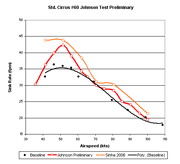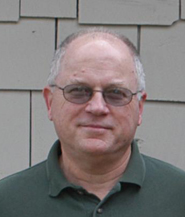|
The day we have anticipated for three years finally arrived. Although consistency issues reported earlier
remain, on the strength of two recent flights
(Measurements Show 20% Improvement!)
Dr. Sinha and I felt that the time was right for independent verification by
Dick Johnson and the Dallas
Glider Association at Caddo Mills, Texas.
It was a risky decision since the present deturbulators fail when condensation inside the deturbulator
tape occludes the pressure equalization vents. But we thought that the improvements were so large
that something significant would show up on any day that was suitable for flight testing,
provided the humidity was reasonably low.
In fact, the two days of deturbulator testing were unseasonably warm and humid; however,
the deturbulators worked well enough to show that deturbulation works, if not how well they can work.
There were significant differences between the two days and large variations within each flight as the
vents sometimes failed to keep up with altitude changes.
Any way you analyze the data, you see significant improvements.
After Dick Johnson presents his results at the SSA Annual Convention in Memphis (February 8-10, 2007),
I will post an analysis that shows the variations in deturbulator performance and convincingly confirms
our prior measurements, albeit in a piecemeal way. Any way you look at the Caddo Mills data, they
document that Sinha Deturbulators produce large improvements.
Six test flights were flown by Dick Johnson and Jeff Baird at Caddo Mills
on Wednesday and Thursday, December 13 and 14, 2006. We then removed the deturbulator tapes from the wings,
returning the glider to standard configuration for baseline and airspeed calibration flights.
Dr. Sinha and I returned home Friday with a lot of anxiety, not knowing the outcome. Then came the news in classic
Johnson understatement:
"Attached are the preliminary flight test sink rate data that we measured with the deturbs installed."
Naturally, Dick will publish this as another in his long series of flight test evaluations. Also, he will
present his findings at the SSA Annual Convention in
Memphis next February 8-10.
After that, we will post on the web our analysis of his data, which will compare his data to our own measurements
reported in earlier progress reports (above).
 However, based on the preliminary results, it appears that the glider has been confirmed to
fly about 15% better than it should.
However, based on the preliminary results, it appears that the glider has been confirmed to
fly about 15% better than it should.
Dick Johnson's data show the characteristic notch in the L/D graph (hump in the polar)
at around 70 kts that we measured.
(Measurements Show 20% Improvement!)
Although undesirable, this is a wonderful thing at this stage of development. For one thing, it
verifies that the deturbulators are working. Seeing it in the Johnson data shows that we are
indeed measuring the same thing. Next, it shows that the deturbulators do no significant
harm when they shut down. Performance returns to the unmodified values.
Finally, when the notch (nearly) grazes the baseline we know that there is no significant
bias in the data from uniform upwelling or subsiding of the airmass.
I am believe we can remove this undesirable feature with little difficulty. But, for now
it's comforting to have around.
One final note. This Standard Cirrus is in very good condition, but not pristine. It was refinished
in Imron in 1996 and flies at max gross weight (728 lbs) with me in it. The wing profile has a 0.010" to 0.015" hump
in the spar region. No special care has been taken to put it into excellent flying
condition. The control seals have holes, there is no box around the
main gear and the doors fit poorly. A relief tube permanently extends from the right gear door.
Also, while there are lower mylar seals on the aileron gaps and internal S-seals, the upper
gaps are open. In a word, this glider is definitely not in competition condition.
Our thanks to Dick Johnson for conducting these tests, Jeff Baird for sharing the piloting duties,
tow pilots David Cheek and Howard Hughes, Paula Lara and her staff at
Southwest Soaring, Inc. and
the Dallas Glider Association (DGA) for funding these flight tests.
Jim Hendrix
Oxford Aero Equipment

|